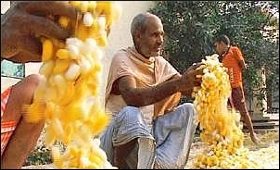|

|
'Extend anti-dumping duty on raw silk imports from China'
|
|

|
|
| Top Stories |
 |
|
|
|
SME Times News Bureau | 04 Apr, 2014
Batting for domestic silk producers, apex industry body ASSOCHAM has recommended extension of anti-dumping duty on imports of raw silk from China till December 2015 in order to boost country's raw silk production.
"India's silk industry is an employment oriented sector as it provides jobs to over 7.6 million people across 51,000 villages operating over 3.28 lakh handlooms and over 45,800 powerlooms with over 8.14 lakh weavers," noted a study titled 'Future of Indian Silk Industry,' conducted by The Associated Chambers of Commerce and Industry of India (ASSOCHAM).
In January 2003, Government of India had imposed an antidumping duty on imports of Mulberry Raw Silk (not thrown) of 2A grade and below from China which remained in force until January 2008 and was subsequently extended till January 2014 after a sunset review.
"Clocking compounded annual growth rate (CAGR) of about eight percent, India's total silk imports have increased from over USD 124 million in 2000-01 to about USD 312 million 2012-13 with raw silk alone comprising for about 73 percent of these imports worth over USD 227 million," highlighted the ASSOCHAM study.
China is biggest exporter of raw silk to India accounting for almost 99 percent of exported raw silk worth USD 224.5 million as of 2012-13, highlighted the study carried out by the ASSOCHAM Economic Research Bureau (AERB). "Raw silk imports from China have grown at over seven percent CAGR during 2000-01 and 2012-13."
Consumption of raw silk in India is likely to rise together with growth in per-capita income which rose from Rs 24,143 in 2004-05 to Rs 39,961 in 2013-14 and also due to increase in consumption expenditure on clothing, it added.
"Supply shortages is the prime issue being faced by Indian silk industry (weaving in particular) as there is a shortfall of over 5,000 metric tonnes (MT) resulting in dependence on silk imports to fulfill domestic needs," said D.S. Rawat, secretary general of ASSOCHAM while releasing the chamber's study.
"Silk import restrictions have two facets; one is concern of sericulture farmers opposing cheap Chinese raw silk imports threatening their livelihood, while the other issue is of the weaving community which requires raw silk to meet the rising demand," said Rawat. "Thus there is a need to strike a balance between the two warring sections of the industry by periodically reviewing the import policy for raw silk taking into account balanced interests of both sericulturists and export manufacturers."
In its study, ASSOCHAM has also highlighted that inconsistency in quality of domestically available silk makes it difficult for use in powerlooms thereby affecting the weaving process which results in dependence on imported raw material.
Besides, silk also faces threat from the competition that seems to be emerging from synthetic fibers such as polyester, it added. “A focused and planned silk promotion campaign could help get back the interest of the consumers.”
With a view to improve silk production in India, the ASSOCHAM has suggested that state governments to promote tie-up of weaver cluster with raw silk production units for establishing close linkage between forward and backward sub-systems resulting in greater efficiency, more so as sericulture and silk industry is highly scattered and unorganized.
Besides, the state governments may also facilitate establishment of weaver centers to empower and enlighten the producers with latest information on research and development, technological advances, new designs to impart technical skills related to weaving techniques and conducting feasibility studies to identify new potential mulberry centers may also help to boost production and further improve both productivity and product quality.
There is a need to undertake wide-scale educative initiatives to disburse the information amid weaving community as they are mostly unaware of welfare schemes provided to them by the State and Central Governments, ASSOCHAM has further suggested.
|
|
|
| |
|
|
|
|
|
|
|
|
|
|
|
|
|
|
| |
| Customs Exchange Rates |
| Currency |
Import |
Export |
US Dollar
|
66.20
|
64.50 |
UK Pound
|
87.50
|
84.65 |
Euro
|
78.25
|
75.65 |
| Japanese
Yen |
58.85 |
56.85 |
| As on 13 Aug, 2022 |
|
|
| Daily Poll |
 |
 |
| PM Modi's recent US visit to redefine India-US bilateral relations |
|
|
|
|
|
| Commented Stories |
 |
|
|
|
|
|
| |
|